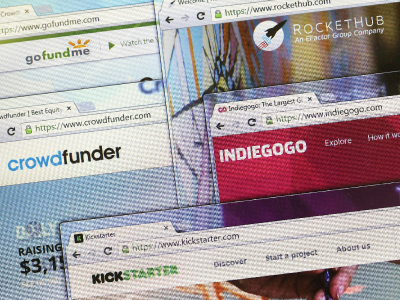How To Crowdfund For Your Venture

Over the last decade, online crowdfunding has changed the fundraising game, and small businesses are reaping the benefits. At its most basic, the concept of crowdfunding (raising small amounts of money from a large amount of people) can be broken down into two distinct categories—donation/reward-based and investment-based.
Nonprofits and cause-centered organizations often use donation/reward-based crowdfunding, while startups and small businesses usually go the route of investment-based crowdfunding, either by taking on debt or offering equity.
Below, you’ll find a simple breakdown of each crowdfunding style, along with some of the most common platforms to help you choose the best fit for your fundraising goals.
Donation/Reward-Based Crowdfunding
This form of crowdfunding has become an attractive alternative to more traditional small business financing, especially for entrepreneurs who lack collateral for a loan, and/or may not be able to afford to pay back their debt immediately. While there are investments of both time and money associated with creating the initial pitch, the format is very affordable and does not require the sacrifice of equity.
Familiar names like Kickstarter, Indiegogo and GoFundMe dominate this space. They require no up-front collateral and do not ask for business financials to be made accessible to the public.
Kickstarter reports the majority of funded projects raise less than $10,000. Despite this meager average, a growing number of campaigns have reached six, seven and even eight figures. Still, while it is possible to raise millions, entrepreneurs should be prepared to supplement with additional fundraising efforts.
One of the drawbacks of this type of crowdfunding is that when individuals do not patent their products, they are at risk of having their idea copied. On the flip side, the exposure the platform provides can create a great deal of brand awareness by reaching audiences that may not have been exposed otherwise.
Equity-Based Crowdfunding
Equity-based crowdfunding is similar to donation-based crowdfunding in that it does not require a repayment. Instead, investors are offered a stake in your company in exchange for their support. Popular platforms include AngelList, Fundable and CircleUp.
To protect those who are new to the space, the SEC has created a set of rules to ensure the equity crowdfunding environment is mutually beneficial for investors and those seeking contributions. As a result, an organization can raise no more than $1 million, and regardless of how wealthy an investor may be, they are only able to contribute up to $100k for a given year.
The extra rules make this process is a bit more involved than that of reward-based crowdfunding, but the average investments also tend to be substantially higher. In fact, raising large amounts of money quickly—SeedInvest reports an average of $500k raised per company on their platform—without the more detailed terms set by VC firms is one of the greatest benefits of this fundraising style.
Of course, entrepreneurs who choose equity crowdfunding must also be prepared to give away a piece of their company to investors, thus allowing investors an opportunity to influence company decisions. Additionally, the fees can add up. Platform fees range from 7-12 percent of raised funds, and then there are payment processing fees that can take up an additional 3-5 percent.
Debt-Based Crowdfunding
Debt-based crowdfunding is regulated in a similar manner to equity-based crowdfunding. The main difference is that funders do not receive a share of equity. Instead, they make loans to a company and get back their principal, plus interest. Additionally, some lenders may invest in a company’s securities with the hope that they will be paid dividends on profit shares, or that the company will grow and they can sell their shares at a higher rate.
Most platforms require credit checks, and only those with good credit ratings will be accepted, making this method of fundraising is best-suited for established companies that are a few years old with steady cash flow and assets to borrow against. Kiva, Funding Circle and Lending Club are a few of the players in this space.
It’s no secret that access to capital is the greatest roadblock to getting innovative ideas to market. So, if you’re struggling to secure a small business loan, or attract the attention of the larger venture capital industry, crowdfunding might just be an excellent alternative.
For more useful tips on getting your venture started the right way, check out JumpStart’s helpful Entrepreneur Toolkit. And don’t forget to sign up for JumpStart for Entrepreneurs, our monthly newsletter giving you more helpful advice along with local success stories and lists of local funding/networking opportunities.